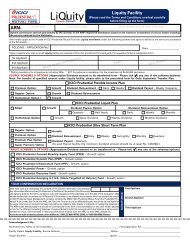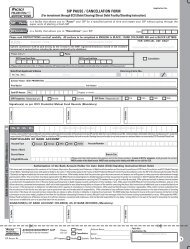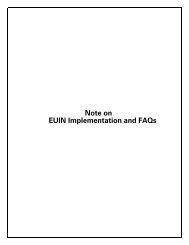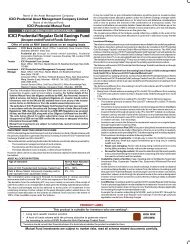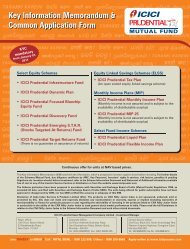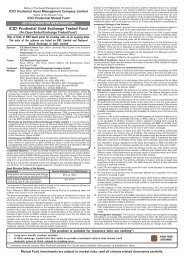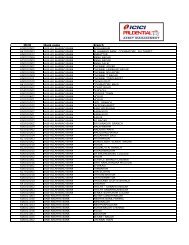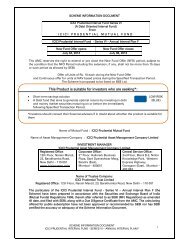February 22, 2013 February 25, 2013 - AMFI
February 22, 2013 February 25, 2013 - AMFI
February 22, 2013 February 25, 2013 - AMFI
Create successful ePaper yourself
Turn your PDF publications into a flip-book with our unique Google optimized e-Paper software.
6. In the event of any deviations from the floor and ceiling of credit ratings specified for<br />
any instrument, the same shall be rebalanced within 30 days from the date of the said<br />
deviation.<br />
7. Securities with rating A1 and AA shall include A1+ & AA+ and A1- & AA- respectively.<br />
8. Further, the allocation may vary during the tenure of the Scheme. Some of these<br />
instances are: (i) coupon inflow; (ii) the instrument is called or bought back by the<br />
issuer (iii) in anticipation of any adverse credit event. In case of such deviations, the<br />
Scheme may invest in Bank CDs of highest rating/ CBLOs/ Repo and Reverse Repo in<br />
Government Securities / Government Securities/ T- Bills.<br />
There would not be any variation from the intended portfolio allocation as stated in the<br />
launch Scheme Information Document / Key Information Memorandum on the final<br />
allocation, except as specified in point nos.1,2,5,6 and 8.<br />
In the event of any deviation from the asset allocation stated above, the Fund Manager<br />
shall review and rebalance the portfolio within 30 days from the date of such deviation<br />
except in case where the deviation is on account of the conditions stated in point 1,2 and<br />
8 above.<br />
The investors/unit holders can ascertain details of portfolio of the Plans as on the last<br />
date of each month on AMC’s website at www.icicipruamc.com which is displayed as<br />
per SEBI Regulations.<br />
Credit Evaluation Policy for investment in debt securities<br />
The AMC aims to identify securities, which offer superior levels of yield at lower levels of<br />
risks so the Investment process is firmly research oriented. It comprises qualitative as<br />
well as quantitative measures. Qualitative factors like management track record, group<br />
companies, resource-raising ability, extent of availability of banking lines, internal control<br />
systems, etc are evaluated in addition to the business model and industry within which<br />
the issuer operates as regards industry/model-specific risks working capital<br />
requirements, cash generation, seasonality, regulatory environment, competition,<br />
bargaining power, etc. Quantitative factors like debt to equity ratio, Profit and loss<br />
statement analysis, balance sheet analysis are taken into further consideration.<br />
Macroeconomic call is taken on interest rate direction by careful analysis of various<br />
influencing factors like Inflation, Money supply, Private sector borrowing, Government<br />
borrowing, Currency market movement, Central Bank policy, Local fiscal and monetary<br />
policy, Global interest rate scenario and Market sentiment. Interest rate direction call is<br />
supplemented by technical analysis of market and short term influencing factors like<br />
trader position, auction/issuance of securities, release of economic numbers, offshore<br />
market position, etc. Interest Rate direction call and anticipation of yield curve movement<br />
forms the basis of portfolio positioning in duration and spread terms. Credit research is<br />
done on a regular basis for corporate having high investment grade rating. Credit<br />
research includes internal analysis of rating rationale, and financial statements (annual<br />
reports and quarterly earnings statements) of the issuer, for the last 1-3 years evaluating<br />
amongst other metrics, relevant ratios of profitability, capital adequacy, gearing, turnover<br />
and other inputs from external agencies. On an ongoing basis, the credit analyst keeps<br />
track of credit profile of the issuer, possible credit risks reflected in change in outlook of<br />
rating agencies, external developments affecting the issuer etc. Internal credit call is a<br />
pre-requisite for all investments since the investment universe is primarily high-grade<br />
credit instruments. Credit research is also used to minimize credit migration risk and for<br />
generating relative value trade ideas. Stable to higher rating on maturity vis-à-vis<br />
issuance is the guiding factor for investment decisions from credit point of view<br />
Scheme Information Document<br />
ICICI Prudential Fixed Maturity Plan – Series 66 – 413 Days - Plan G<br />
16




